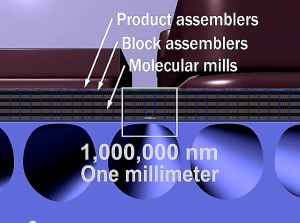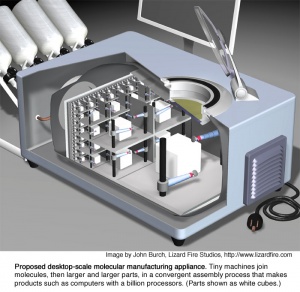Difference between revisions of "Gem-gum technology"
(→Tooltips) |
m (→Tooltips) |
||
| Line 83: | Line 83: | ||
= Tooltips = | = Tooltips = | ||
| − | [Tooltip cycle; DC10c;...] [[tooltip | + | [Tooltip cycle; DC10c;...] [[tooltip chemistry]] |
Revision as of 17:13, 5 December 2013
The kind of products in this technology level are outlined in the definition of APM on the Main Page.
This page should give more details to the different aspects of advanced APM systems.
previous: technology level II
next: further improvement at technology level III
Contents
Productive nanosystems
In the beginning of APM research only assemblers where considered for reachig the capability to produce macroscopic amounts of a product.
At T.Level III it turns out that Advanced nanofactories are more balanced and efficient than Assembler systems. At technology level I the border between minimal assemblers and rudimentary nanofactories is more blurred. A rudimentary nanofactory might be buildabel without self replicon but a simplified two dimentional assembler model might work well too.
To have an umbrella term for both ideas The term productive nanosystems was introduced.
Using the whole volume for the building process of the product rather than a layer in the "classic" nanofactory design could speed up the building process. But this will not be neccesary for practical usage [TODO find existing proof]. If you build a solid block though you might end up to being slower than with the layer method due to the fractal growth speedup limit
Assembly levels
The assambly process of AP products can be clearly divided in a number of subsequent steps no matter whether the concrete implementetion of a productive nanosytem looks more like a nanofactory or more like an assembler system. Those steps are implementation agnostic. Further details can de found on the assembly levels page.
Assemblers
Note: Assemblers are deprecated!
The idea is to create a machine with sidelengths of a few hundred nanometers which packages all the functionaliy to produce useful products and also make copies of itself.
This way you get an exponential rate of reproduction and can produce macroscopic goods in reasonable amounts of time.
It turned out that packaging all the functionality into such a small package is a rather unbalanced and inefficient approach for T.Level III.
[TODO add more detailed explanation with assembly levels]
Quite a bit of thought was put into this model.
Either they where sopposed to swim about in a solution or there was some form of movement mechanism in a machine phase scaffold crystal envisioned like:
- sliding cubes [TODO add references]
- legged blocks [TODO add references]
The combination of their appearance (legs) with their very tightly packed capability of self replication led to the situation that the public started to perceive this technology as swarms of tiny life like nano-bugs that could potentially start uncontrollable and unstoppable self replication. Why this is a rather missinformed opinion can be read up here.
The methods for movement are still relevant for higher assembly levels in nanofactories for transport of microcomponents. [and self repair by microcomponent replavcement ..]
The legged block mobility design is also known from the concept of Utility Fog (speculativity warning) but has other design priorities in an manufacturing context like more rigidity and less "intelligence".
Advanced nanofactories
An artistic depiction of a nanofactory.
Note that only assemly level IV (convergent assembly) is visible in this picture.
The official productive nanosystem video [1] shows all the other assembly levels except IV.
Design levels
APM systems can depending on the size of the chunk of them that is under considereration be designed at three different levels:
- atomistic level
- lower bulk limit
- system level
Further details can de found on the design levels page.
Diamondoid Molecular Elements (DMEs)
At the core an advanced productive APM systems consist out of DMEs.
DMEs can be designed either directly at the atomistic level or in lower bulk limit form.
There are two types of DMEs:
- Diamondoid Molecular machine elements DMMEs
- Diamondoid Molecular structural elements DMSEs
Furthere details can be found diamondoid molecular elements page.
Certain standard sets like housing components or a minimal set of compatible DMMEs are needed.
Potential structural and machine elements that seem suitable to port them to DME designs can be found here:
- Thingiverse collection I
- [Todo: add further resources]
Depending on the design different degrees of modifications need to be done.
All degrees of freedome need to be controlled, wall thicknesses need to be increased, atomic roughness must be considered, ...
Logistics
Part of system level design...
- Data
- Energy
- Raw Material
- Waste
Tooltips
[Tooltip cycle; DC10c;...] tooltip chemistry


